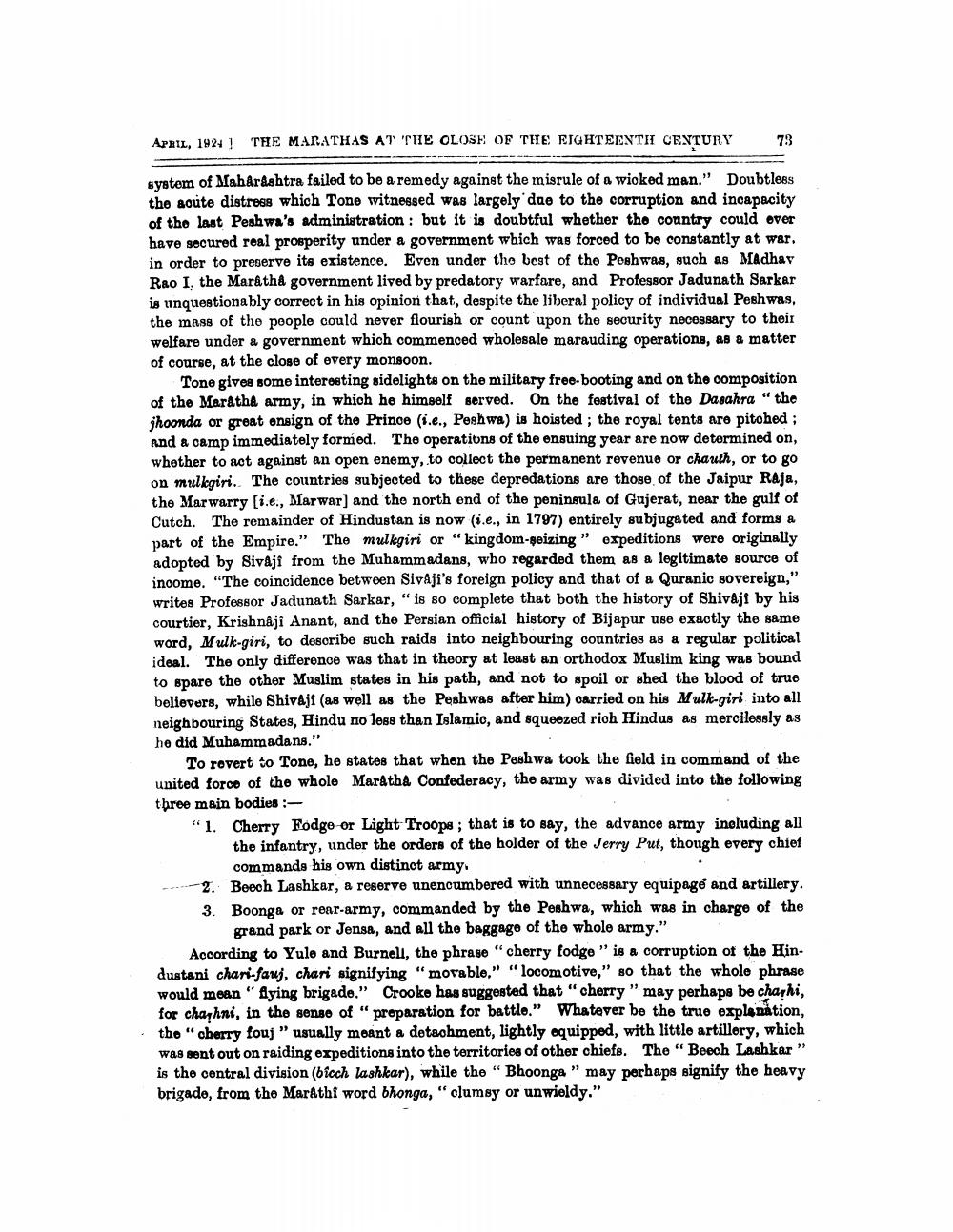________________
APRIL 1924 ! THE MARATHAS AT THE OLOSE OF THE EIGHTEENTH CENTURY
73
system of Maharashtra failed to be a remedy against the misrule of a wicked man." Doubtless the acute distress which Tone witnessed was largely due to the corruption and incapacity of the last Peshwa's administration : but it is doubtful whether the country could ever have secured real prosperity under a government which was forced to be constantly at war, in order to preserve its existence. Even under the best of the Poshwas, such as Madhav Rao I, the Marathå government lived by predatory warfare, and Professor Jadunath Sarkar is unquestionably correct in his opinion that, despite the liberal polioy of individual Peshwas, the mass of the poople could never flourish or count upon the security necessary to their welfare under a government which commenced wholesale marauding operations, as a matter of course, at the close of every monsoon.
Tone gives some interesting sidelights on the military free-booting and on the composition of the Maratha army, in which he himself served. On the festival of the Dasahra " the jhoonda or great onsign of the Prinoe (i.e., Peshwa) is hoisted; the royal tents are pitohed; and a camp immediately formed. The operations of the ensuing year are now determined on, whether to act against an open enemy, to collect the permanent revenue or chauth, or to go on mulkgiri. The countries subjected to these depredations are those of the Jaipur Raja, the Marwarry [i.e., Marwar) and the north end of the peninsula of Gujerat, near the gulf of Cutch. The remainder of Hindustan is now (i.e., in 1797) entirely subjugated and forms a part of the Empire." The mulkgiri or "kingdom-geizing " expeditions were originally adopted by Sivaji from the Muhammadans, who regarded them as a legitimate source of income. "The coincidence between Sivaji's foreign policy and that of a Quranic sovereign," writes Professor Jadunath Sarkar, "is so complete that both the history of Shivaji by his courtier, Krishnaji Anant, and the Persian official history of Bijapur use exactly the same word, Mulk-giri, to describo such raids into neighbouring countries as a regular political ideal. The only difference was that in theory at least an orthodox Muslim king was bound to spare the other Muslim states in his path, and not to spoil or shed the blood of true believers, while Shivaji (as well as the Peshwas after him) carried on his Mulk-giri into all neighbouring States, Hindu no less than Islamio, and squeezed rich Hindus as mercilessly as he did Muhammadans."
To rovert to Tone, he states that when the Peshwa took the field in command of the united forco of tho wholo Maratha Confederacy, the army was divided into the following three main bodies :"1. Cherry Fodge or Light Troops ; that is to say, the advance army including all
the infantry, under the orders of the holder of the Jerry Put, though every chief
commands his own distinot army. 2. Beech Lashkar, a reserve unencumbered with unnecessary equipage and artillery. 3. Boonga or renr-army, commanded by the Peshwa, which was in charge of the
grand park or Jensa, and all the baggage of the whole army." According to Yule and Burnell, the phrase "cherry fodge " is a corruption of the Hindustani chari-fauj, chari signifying "movable," "locomotive," so that the whole phrase would mean "flying brigade." Crooke has suggested that "cherry "may perhaps be charhi, for chashni, in the sense of "preparation for battle." Whatever be the true explanation, the "cherry touj " usually meant a detachment, lightly equipped, with little artillery, which was sent out on raiding expeditions into the territories of other chiefs. The "Beech Lashkar" is the central division (bicch lashkar), while the "Bhoonga" may perhaps signify the heavy brigade, from the Marathi word bhonga, "clumsy or unwieldy."




